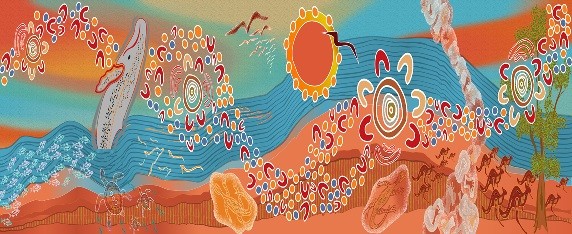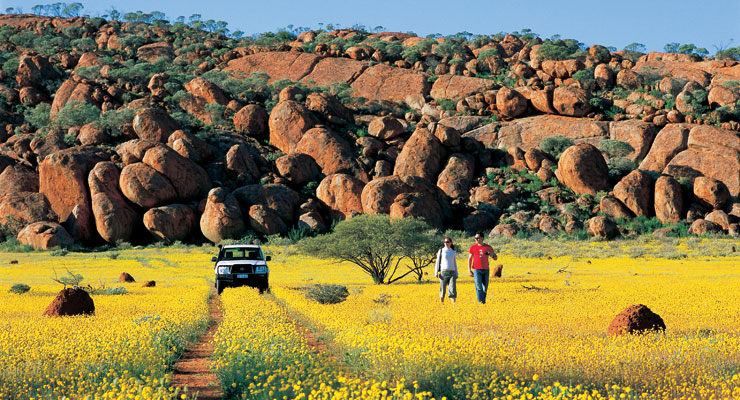PICTURE: This artwork shares cultural narratives in traditional symbolism of the Land of Awabakal.Flowing across the design is songlines on country, reflective of Awabakal people, as the people of the hills and plains. Prepared by Saretta Art & Design
Voice of Country Pledge – an invitation
To bring culture and Country back from the brink, we need a culture of connectedness – of listening to the land.
This is an invitation to all Australians – whether we’re Indigenous or not – to care for and heal Country. To take responsibility as a caretaker of this land and accept our role as a custodian – to listen to and amplify the voices of First Nations people, who have cared for Country since time immemorial.
For thousands of years Aboriginal people lived in harmony with this country and the species that evolved here. The past two centuries have seen nothing but a constant decline of our plants, wildlife, soil and water due to the introduction and lack of control of invasive species. Today they are the biggest threat to our native species.
Invasive species are destroying our totems and degrading our land and sea. Our Country is crying out for an end to this damage. The Invasive Species Council is asking us to take the pledge, to be a Voice of Country.
________________________________________________________________________
First Nations Food Companion: How to buy, cook, eat and grow Indigenous Australian ingredients.
We know more about pine nuts than bunya nuts, kale than warrigal greens, but there’s an edible pantry of unique flavours that First Nations people have been making the most of long before anyone came up with the word ‘foodie’.
An informative guide to more than 60 of the most accessible Indigenous ingredients, along with tips for how to buy, grow and store them.
________________________________________________________________________
The Way of the Ancestors and how it can help us hear The Voice
Janet McCalman AC , Emeritus Redmond Barry Distinguished Professor, The University of Melbourne. (The Conversation, October 3, 2023)
The disintegration of any accord between colonised and colonising, between Indigenous Australia and the rest of us, under the barrage of resentment, lies and calculated incomprehension of the “No” campaign, is a consequence of the continuing ignorance on the part of the colonisers.
The book, The Way of the Ancestors, opens a window into the private Aboriginal world of law, justice and politics. Much remains the secret business of men and women, but we can now begin to understand the moral frameworks of human governance among our First Nations.
Indigenous land law became part of the common law after Mabo, as have, more recently, the traditional adoption laws of the Torres Strait Islanders. But the thrust of The Way of the Ancestors goes deeper into the law governing human relationships, authority, justice, reconciliation, and the settling of grievances (Makarrata). Corn and Langton’s book is about the purpose of law, rather than the letter.
_________________________________________________________________________
 Picture: Artistic depiction of Munibung Hill, the location of eagle hawk flying above Eagle Hawk Stones and rock tools for collecting ochre (see story below). Credit: Art by Saretta Fielding
Picture: Artistic depiction of Munibung Hill, the location of eagle hawk flying above Eagle Hawk Stones and rock tools for collecting ochre (see story below). Credit: Art by Saretta Fielding
Yarns Parai
Cultural stories of the Lower Hunter region
Project overview
The Lower Hunter Freight Corridor will enable a future dedicated freight rail line to be constructed between Fassifern and Hexham; bypassing Newcastle while improving regional and interstate links.
The artwork shares traditional Awabakal Stories and values of the land covered by the corridor investigation.
Previous investigations undertaken by Transport for NSW indicated the potential corridor routes could pass through areas of cultural and archaeological sensitivity. In developing the preferred option Transport wanted to ensure that the process was fully informed of the Aboriginal cultural landscape and Aboriginal community aspirations.
.. On the eastern side of Lake Macquarie there is a stone circle design with an eagle flying above symbolic of the Eagle-Hawk stones.
.. Located on Munibung Hill the stones are a circular erection of about 5 or 6 feet (1.5-1.8 m) in diameter and 2 or 3 feet (60-90 cm) high. Legend is that they were brought there by an eagle-hawk.
.. Click to read the background and to listen to the story of the eagle-hawk stones on Munibung Hill.
.. Munibung Hill was also a site where rocks for tools and a special stone were found to make yellow ochre. The cultural quarry is presented through the stone axe imagery.
________________________________________________________________________
David Marr’s reckoning with his family’s brutal past
Richard Fidler, in Conversation with David Marr (ABC RN, Broadcast 10 Oct 2023)
A FEW YEARS AGO while researching his family tree, David found a photo of his great-great-grandfather, Reg Uhr. In the picture Reg was in uniform as an officer of the Native Police.
David discovered Reg had led many murderous expeditions into NSW and Queensland under instructions to clear the land of Aboriginal people by any means necessary.
Digging further into his family story, David found a tale of fortunes made and lost during the bloodiest years of Australia’s frontier wars. LISTEN HERE
Further information: Killing for Country is published by Black Inc
Credits: Eliza Kirsch, Executive Producer / Richard Fidler, Presenter
_________________________________________________________________________
Neuroscience Psychology
Indigenous Insights: A New Lens on Consciousness
Radek Trnka, Prague College of Psychosocial Studies October 14, 2023
A NEW STUDY ILLUMINATES the profound depth and adaptability embedded within Indigenous interpretations of consciousness, offering fresh perspectives and adaptive solutions for contemporary scientific discourse.
Instead of adhering to a singular, individualistic viewpoint, Indigenous concepts of consciousness often intertwine with environmental, relational, and spiritual facets, providing a holistic perspective that balances individual and global consciousness.
The study emphasizes that embracing this ancient wisdom could forge pathways toward a more inclusive, interconnected scientific understanding of consciousness. The findings not only promote cross-cultural appreciation but also underscore the vital necessity of preserving and respecting Indigenous knowledge systems.
Key Facts:
- Beyond Individualism: Indigenous interpretations of consciousness tend to weave the individual into a broader, interconnected relationship with the environment and spiritual beliefs, offering a more relational perspective than typically explored in contemporary science.
- Harmony in Duality: Indigenous understandings promote a holistic view that doesn’t oppose local and global consciousness, but rather integrates them, providing a unified perspective of interconnectedness among all living entities.
- Potential Applications: Indigenous perspectives on consciousness could bring fresh insights to scientific debates on various aspects like material versus non-material sources of consciousness and the intertwining of consciousness with environmental aspects.
Source: Prague College of Psychosocial Studies
……………………………………………………………………………………………………………………….
Denmark (WA) school brings Indigenous knowledge into the classroom with bracken fern experiment
Piper Duffy. ABC News, Great Southern, Fri 27 Oct 2023.
Western Australian schools are finding more ways to incorporate Indigenous knowledge into everyday learning, with a recent trip to the bush by a group of teachers revealing a very useful tip for bushwalkers and hikers.
Farmers or foragers? Pre-colonial Aboriginal food production was hardly that simple
Michael Westaway, Australian Research Council Future Fellow, Archaeology, School of Social Science, The University of Queensland and four co-authors (THE CONVERSATION, November 10, 2023)
In our new research published in the Archaeology of Food and Foodways, we argue that to better understand millennia-old systems, archaeologists must engage deeply with fields such as plant genetics, ethnobotany, archaeobotany and bioarchaeology as well as listening more carefully to the views of Aboriginal people.
…………………………………………………………………………………………………………………….
From MMM Issue 41, Dec 23 – Jan 24



